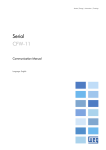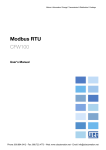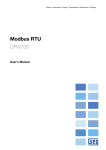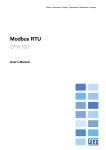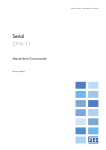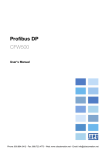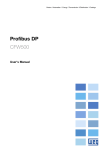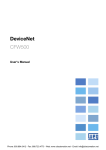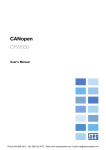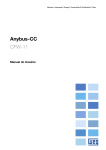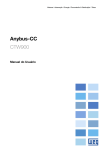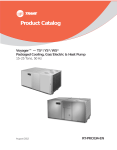Download WEG CFW500 Variable Frequency Drives Modbus RTU User`s Manual
Transcript
Modbus RTU CFW500 User’s Manual Phone: 800.894.0412 - Fax: 888.723.4773 - Web: www.ctiautomation.net - Email: [email protected] Modbus RTU User’s Manual Series: CFW500 Language: English Document Number: 10002253377 / 00 Publication Date: 06/2013 Phone: 800.894.0412 - Fax: 888.723.4773 - Web: www.ctiautomation.net - Email: [email protected] CONTENTS CONTENTS ......................................................................................................................... 3 ABOUT THIS MANUAL ...................................................................................................... 5 ABBREVIATIONS AND DEFINITIONS ......................................................................................................... 5 NUMERICAL REPRESENTATION ............................................................................................................... 5 DOCUMENTS ................................................................................................................................................ 5 1 INTRODUCTION TO SERIAL COMMUNICATION ...................................................... 6 2 INTERFACE DESCRIPTION ......................................................................................... 7 2.1 PLUG-IN MODULES WITH RS485 INTERFACE .............................................................................. 7 2.1.1 RS485 connector for the standard plug-in module (CFW500-IOS) ....................................... 7 2.2 PLUG-IN MODULES WITH RS485 INTERFACE AND ADDITIONAL INTERFACE ........................ 7 2.2.1 Plug-in module with two RS485 interfaces (CFW500-CRS485) ............................................ 8 2.2.2 Plug-in module with RS485 and USB interfaces (CFW500- CUSB) ...................................... 8 2.2.3 Plug-in module with RS485 and RS232 interfaces (CFW500-CRS232) ................................ 9 2.3 RS485.................................................................................................................................................. 9 2.3.1 RS485 Interface Characteristics .............................................................................................. 9 2.3.2 Terminating resistor .................................................................................................................. 9 2.3.3 Indications .................................................................................................................................. 9 2.3.4 Connection with the RS485 Network ....................................................................................... 9 2.4 RS232................................................................................................................................................ 10 2.4.1 Indications ................................................................................................................................ 10 2.4.2 Connection with the RS232 Network ..................................................................................... 10 2.4.3 Cables for the RS232 Connection .......................................................................................... 10 3 PROGRAMMING ........................................................................................................ 11 3.1 SYMBOLS FOR THE PROPERTIES DESCRIPTION...................................................................... 11 P0105 – 1ST/2ND RAMP SELECTION .......................................................................................................... 11 P0220 – LOCAL/REMOTE SELECTION SOURCE .................................................................................... 11 P0221 – SPEED REFERENCE SELECTION – LOCAL SITUATION ......................................................... 11 P0222 – SPEED REFERENCE SELECTION – REMOTE SITUATION ...................................................... 11 P0223 – FORWARD/REVERSE SELECTION – LOCAL SITUATION ........................................................ 11 P0224 – RUN/STOP SELECTION – LOCAL SITUATION .......................................................................... 11 P0225 – JOG SELECTION – LOCAL SITUATION ..................................................................................... 11 P0226 – FORWARD/REVERSE SELECTION – REMOTE SITUATION .................................................... 11 P0227 – RUN/STOP SELECTION – REMOTE SITUATION ...................................................................... 11 P0228 – JOG SELECTION – REMOTE SITUATION .................................................................................. 11 P0308 – SERIAL ADDRESS........................................................................................................................ 11 P0310 – SERIAL BAUD RATE .................................................................................................................... 12 P0311 – SERIAL INTERFACE BYTE CONFIGURATION .......................................................................... 12 P0312 – SERIAL PROTOCOL..................................................................................................................... 12 P0313 – COMMUNICATION ERROR ACTION .......................................................................................... 13 P0314 – SERIAL WATCHDOG ................................................................................................................... 14 P0316 – SERIAL INTERFACE STATUS ..................................................................................................... 14 P0680 – STATUS WORD ............................................................................................................................ 14 P0681 – MOTOR SPEED IN 13 BITS ......................................................................................................... 15 P0682 – SERIAL CONTROL WORD ........................................................................................................... 16 P0683 – SERIAL SPEED REFERENCE ...................................................................................................... 16 P0695 – DIGITAL OUTPUT SETTING ........................................................................................................ 17 P0696 – VALUE 1 FOR ANALOG OUTPUTS ............................................................................................. 18 P0697 – VALUE 2 FOR ANALOG OUTPUTS ............................................................................................. 18 P0698 – VALUE 3 FOR ANALOG OUTPUTS ............................................................................................. 18 Phone: 800.894.0412 - Fax: 888.723.4773 - Web: www.ctiautomation.net - Email: [email protected] 4 MODBUS RTU PROTOCOL ....................................................................................... 19 4.1 TRANSMISSION MODES ................................................................................................................ 19 4.2 MESSAGE STRUCTURE FOR RTU MODE .................................................................................... 19 4.2.1 Address ..................................................................................................................................... 19 4.2.2 Function Code .......................................................................................................................... 19 4.2.3 Data Field .................................................................................................................................. 19 4.2.4 CRC ........................................................................................................................................... 19 4.2.5 Time Between Messages ........................................................................................................ 19 5 OPERATION IN THE MODBUS RTU NETWORK – SLAVE MODE .......................... 21 5.1 5.2 6 AVAILABLE FUNCTIONS AND RESPONSE TIMES ...................................................................... 21 MEMORY MAP................................................................................................................................. 21 DETAILED DESCRIPTION OF THE FUNCTIONS ..................................................... 23 6.1 FUNCTION 03 – READ HOLDING REGISTER ............................................................................... 23 6.2 FUNCTION 06 – WRITE SINGLE REGISTER ................................................................................. 23 FUNCTION 16 – WRITE MULTIPLE REGISTERS ..................................................................................... 24 6.3 FUNCTION 43 – READ DEVICE IDENTIFICATION ........................................................................ 25 6.4 COMMUNICATION ERRORS .......................................................................................................... 25 7 FAULTS AND ALARMS RELATED TO THE MODBUS RTU COMMUNICATION .... 27 A128/F228 – TIMEOUT FOR SERIAL COMMUNICATION ....................................................................... 27 I. APPENDICES.............................................................................................................. 28 APÊNDICE A. APÊNDICE B. ASCII TABLE ................................................................................................................... 28 CRC CALCULATION USING TABLES ........................................................................... 29 Phone: 800.894.0412 - Fax: 888.723.4773 - Web: www.ctiautomation.net - Email: [email protected] ABOUT THIS MANUAL This manual supplies the necessary information for the operation of the CFW500 frequency inverter using the Modbus RTU protocol. This manual must be used together with the CFW500 user manual. ABBREVIATIONS AND DEFINITIONS ASCII CRC EIA TIA RTU American Standard Code for Information Interchange Cycling Redundancy Check Electronic Industries Alliance Telecommunications Industry Association Remote Terminal Unit NUMERICAL REPRESENTATION Decimal numbers are represented by means of digits without suffix. Hexadecimal numbers are represented with the letter ‘h’ after the number. Binary numbers are represented with the letter ‘b’ after the number. DOCUMENTS The Modbus RTU protocol was developed based on the following specifications and documents: Document MODBUS Application Protocol Specification, December 28th 2006. MODBUS Protocol Reference Guide, June 1996. MODBUS over Serial Line, December 20th 2006. Version V1.1b Source MODBUS.ORG Rev. J V1.02 MODICON MODBUS.ORG In order to obtain this documentation, consult MODBUS.ORG, which is nowadays the organization that keeps, publishes and updates the information related to the Modbus protocol. Phone: 800.894.0412 - Fax: 888.723.4773 - Web: www.ctiautomation.net - Email: [email protected] 1 INTRODUCTION TO SERIAL COMMUNICATION In a serial interface the data bits are sent sequentially through a communication channel or bus. Several technologies use the serial communication for data transfer, including the RS232 and RS485 interfaces. The directions that specify the RS232 and RS485 standards, however, do neither specify the character format, nor its sequence for the data transmission and reception. Therefore, besides the interface, it is also necessary to identify the protocol used for the communication. Among the several existent protocols, one used a lot in the industry is the Modbus RTU protocol. In the sequence the characteristics of the RS232, RS485 and USB serial interfaces available for the product will be presented, as well as the Modbus RTU protocol for the use of this interface. Phone: 800.894.0412 - Fax: 888.723.4773 - Web: www.ctiautomation.net - Email: [email protected] 2 INTERFACE DESCRIPTION The interfaces for serial communication RS232, RS485 or USB available for the CFW500 frequency inverter depend on the selected plug-in module for the product. Following are presented information about the connection and installation of the equipment, using different plug-in modules. 2.1 PLUG-IN MODULES WITH RS485 INTERFACE Figure 2.1: Example of CFW500 plug-in module All plug-in modules for CFW500 frequency inverter have at least one standard RS485 interface, identified as Serial (1). This standard RS485 interface has two functions: Point to Point Connection with remote keypad. Connection via RS485 for network operation. The selection of the function that will be used for the product is made using parameter P0312. 2.1.1 RS485 connector for the standard plug-in module (CFW500-IOS) For the standard plug-in module, the connection to the RS485 interface is available via the control terminal using the following pin assignment: Pin 12 14 16 Name A-Line (-) B-Line (+) GND Function RxD/TxD negative RxD/TxD positive 0V isolated from the RS485 circuit Table 2.1: RS485 connector pinout for standard plug-in module (CFW500-IOS) 2.2 PLUG-IN MODULES WITH RS485 INTERFACE AND ADDITIONAL INTERFACE Depending on the installed plug-In module, CFW500 has up to two serial interfaces simultaneously, but only one can be the source of commands or references, the other is necessarily inactive or remote keypad as the selection of P0312. The Serial (1) Interface is the standard interface CFW500 and is present in all plug-In modules via the terminals of the standard RS485 port. The Serial (2) interface is present only in the Plug-In modules described below: Phone: 800.894.0412 - Fax: 888.723.4773 - Web: www.ctiautomation.net - Email: [email protected] NOTE! It is not possible use the serial interfaces for communication with two different networks. The only allowed simultaneous operation is using Serial (1) connected to the remote keypad, and another programmed protocol to Serial (2). 2.2.1 Plug-in module with two RS485 interfaces (CFW500-CRS485) Figure 2.2: Plug-in module with additional RS485 For this plug-in module, besides the standard RS485 interface, a second RS485 interface is available. This accessory allows simultaneous connection of a remote HMI in the standard RS485 serial interface, plus a programmable RS485 interface. 2.2.2 Plug-in module with RS485 and USB interfaces (CFW500- CUSB) Figure 2.3: Plug-in module with USB connection For this plug-in module, besides the standard RS485 interface, a USB interface with mini-USB connector is available. When connecting the USB interface, it will be recognized as a USB to serial converter, and a virtual COM port will be created 1. Thus communication is made with the drive via this COM port. The USB accessory also provides the connection to the remote keypad via standard RS485 interface. 1 It is necessary to install the USB driver on the CD-ROM supplied with the product. The COM port number created depends on the availability in the operating system and, once connected, consult the hardware resources of the system to identify this port. Phone: 800.894.0412 - Fax: 888.723.4773 - Web: www.ctiautomation.net - Email: [email protected] 2.2.3 Plug-in module with RS485 and RS232 interfaces (CFW500-CRS232) Figure 2.4: Plug-in module with RS232 connection For this plug-in module, besides the standard RS485 interface, an RS232 interface is available. This accessory allows simultaneous connection of a remote HMI in the standard RS485 serial interface, plus a programmable RS232 interface. 2.3 RS485 2.3.1 RS485 Interface Characteristics The interface follows the EIA-485 standard. It allows communication baud rates from 9600 up to 38400 Kbit/s. The interface is electrically isolated and with differential signal, which grants more robustness against electromagnetic interference. It allows the connection of up to 32 devices to the same segment. More devices can be connected by using repeaters 2. A maximum bus length of 1000 meters. 2.3.2 Terminating resistor It is necessary to enable a terminating resistor at both ends of the main bus for each segment of the RS485 network. There are switches in the CFW500 frequency inverter that can be activated to enable the terminating resistor. Refer to the plug-in installation guide for details. 2.3.3 Indications Details on the alarms, communications failures and communication states are made through the keypad (HMI) and product parameters. 2.3.4 Connection with the RS485 Network The following points must be observed for the connection of the device using the RS485 interface: 2 It is recommended the use of a shielded cable with a twisted pair of wires. It is also recommended that the cable has one more wire for the connection of the reference signal (GND). In case the cable does not have the additional wire, then the GND signal must be left disconnected. The cable must be laid separately (and far away if possible) from the power cables. All the network devices must be properly grounded, preferably at the same ground connection. The cable shield must also be grounded. Enable the termination resistors only at two points, at the extremes of the main bus, even if there are derivations from the bus. The limit number of devices that can be connected to the network depends also on the used protocol. Phone: 800.894.0412 - Fax: 888.723.4773 - Web: www.ctiautomation.net - Email: [email protected] 2.4 RS232 2.4.1 Indications Details on the alarms, communications failures and communication states are made through the keypad (HMI) and product parameters. 2.4.2 Connection with the RS232 Network The inverter RX and TX signals must be respectively connected to the master TX and RX signals, besides the reference signal (GND) connection. The RS232 interface is very susceptible to interference. For that reason the cable used for the communication must be as short as possible – always less than 10 meters – and must be laid separately from the power input and motor cables. 2.4.3 Cables for the RS232 Connection In case it is wished, it is available the following cables for the connection in RS232 between the CFW500 frequency inverter and a network master, as a PC for instance: Cable Shielded RS232 cable with a DB9 female connector Length: 3 meters Shielded RS232 cable with a DB9 female connector Length: 10 meters Part Number 10050328 10191117 Other cables, however, can be found in the market – generally called null-modem – or assembled according to what is wished for the installation. Phone: 800.894.0412 - Fax: 888.723.4773 - Web: www.ctiautomation.net - Email: [email protected] 3 PROGRAMMING Next, the CFW500 frequency inverter parameters related to the Modbus RTU communication will be presented. 3.1 SYMBOLS FOR THE PROPERTIES DESCRIPTION RO CFG Reading only parameter Parameter that can be changed only with a stopped motor. P0105 – 1ST/2ND RAMP SELECTION P0220 – LOCAL/REMOTE SELECTION SOURCE P0221 – SPEED REFERENCE SELECTION – LOCAL SITUATION P0222 – SPEED REFERENCE SELECTION – REMOTE SITUATION P0223 – FORWARD/REVERSE SELECTION – LOCAL SITUATION P0224 – RUN/STOP SELECTION – LOCAL SITUATION P0225 – JOG SELECTION – LOCAL SITUATION P0226 – FORWARD/REVERSE SELECTION – REMOTE SITUATION P0227 – RUN/STOP SELECTION – REMOTE SITUATION P0228 – JOG SELECTION – REMOTE SITUATION These parameters are used in the configuration of the command source for the CFW500 frequency inverter local and remote situations. In order that the device be controlled through the Modbus RTU interface, the options ‘serial’ available in these parameters, must be selected. The detailed description of these parameters is found in the CFW500 programming manual. P0308 – SERIAL ADDRESS Range: 1 to 247 Properties: CFG Access groups via HMI: Default: 1 NET Description: It allows programming the address used for the inverter serial communication. It is necessary that each device in the network has an address different from all the others. P0312 = 0 (HMI) → programming needn’t address. P0312 = 1 (Modbus RTU) → valid addresses: 1 to 247. P0312 = 6 (HMI/Modbus RTU) → standard interface = HMI (needn’t address). → additional interface = Modbus RTU (Valid addresses: 1 to 247). Phone: 800.894.0412 - Fax: 888.723.4773 - Web: www.ctiautomation.net - Email: [email protected] P0310 – SERIAL BAUD RATE Range: 0 = 9600 bits/s 1 = 19200 bits/s 2 = 38400 bits/s Properties: CFG Access groups via HMI: Default: 1 NET Description: It allows programming the baud rate for the serial communication interface, in bits per second. This baud rate must be the same for all the devices connected to the network. NOTE! To use the RS485 interface with the remote keypad it is not necessary to set the baud rate. This setting is necessary only with the other serial protocols, for both the standard interface (1) as the additional interface (2). P0311 – SERIAL INTERFACE BYTE CONFIGURATION Range: 0 = 8 data bits, no parity, 1 stop bit 1 = 8 data bits, even parity, 1 stop bit 2 = 8 data bits, odd parity, 1 stop bit 3 = 8 data bits, no parity, 2 stop bits 4 = 8 data bits, even parity, 2 stop bits 5 = 8 data bits, odd parity, 2 stop bits Properties: CFG Access groups via HMI: NET Default: 1 Description: It allows programming the number of data bits, parity and stop bits of the serial interface bytes. This configuration must be identical for all the devices connected to the network. NOTE! To use the RS485 interface with the remote keypad it is not necessary to set the byte configuration. This setting is necessary only with the other serial protocols, for both the standard interface (1) as the additional interface (2). P0312 – SERIAL PROTOCOL Range: 0 = HMI (1) 1 = Reserved 2 = Modbus RTU (1) 3 = Not used 4 = Not used 5 = Not used 6 = HMI (1) / Modbus RTU (2) Properties: CFG Access groups via HMI: NET Default: 2 Description: It allows selecting the desired protocol for the serial interface. Phone: 800.894.0412 - Fax: 888.723.4773 - Web: www.ctiautomation.net - Email: [email protected] Table 3.1: P0312 options Option 0 = HMI (1) 1 = Reserved 2 = Modbus RTU (1) 3 ... 5 = Reserved 6 = HMI (1) e Modbus RTU (2) Description For the standard RS485 interface (1), this option selects the remote HMI communication protocol. For the standard RS485 interface (1), this option selects Modbus RTU slave as the communication protocol. For the interface modules with more than one serial interface (example: CFW500-CUSB, etc.), this option allows to use the remote HMI connected to standard interface (1), and simultaneously, to use Modbus RTU slave protocol at the additional serial interface (2). P0313 – COMMUNICATION ERROR ACTION Range: 0 = Inactive 1 = Disable via Run/Stop 2 = Disable via General Enable 3 = Change to Local 4 = Change to Local keeping commands and reference 5 = Causes a Fault Properties: CFG Access groups via HMI: NET Default: 1 Description: It allows the selection of the action to be executed by the device, if it is controlled via network and a communication error is detected. Table 3.2: P0313 options Options 0 = Inactive 1 = Disable via Run/Stop 2 = Disable via General Enable 3 = Change to Local 4 = Change to Local keeping commands and reference 5 = Causes a Fault Description No action is taken and the drive remains in the existing status. A stop command with deceleration ramp is executed and the motor stops according to the programmed deceleration ramp. The drive is disabled by removing the General Enabling and the motor coasts to stop. The drive commands change to Local. The drive commands change to Local, but the status of the enabling and speed reference commands received via network are kept, providing that the drive has been programmed to use in Local mode the commands via HMI, or 3-wire start/stop and speed reference via either HMI or electronic potentiometer. Instead of an alarm, the communication error causes an drive fault, so that a drive fault reset becomes necessary in order to restore normal operation. The following events are considered communication errors: Serial communication (RS485): A128 alarm/F228 fault: Serial communication timeout The actions described in this parameter are executed by means of the automatic writing of the selected actions in the respective bits of the interface control words. Therefore, in order that the commands written in this parameter be effective, it is necessary that the device be programmed to be controlled via the used network interface (with exception of option “Causes a Fault”, which blocks the equipment even if it is not controlled by network). This programming is achieved by means of parameters P0220 to P0228. Phone: 800.894.0412 - Fax: 888.723.4773 - Web: www.ctiautomation.net - Email: [email protected] P0314 – SERIAL WATCHDOG Range: 0.0 to 999.0s Properties: CFG Access groups via HMI: Default: 0.0 NET Description: It allows programming a time limit for the detection of serial interface communication error. If the frequency inverter remains without receiving valid telegrams longer than the time programmed in this parameter, it will be considered that a communication error has occurred, the alarm A128 will be showed on the HMI and the option programmed in P0313 will be executed. After being powered up, the frequency inverter starts counting this time from the first received valid telegram. The value 0.0 disables this function. P0316 – SERIAL INTERFACE STATUS Range: Default: - 0 = Inactive 1 = Active 2 = Watchdog error Properties: RO Access groups via HMI: NET Description: It allows identifying whether the RS485 serial interface board is properly installed, and whether the serial communication presents errors. Table 3.3: P0316 options Options Description Inactive serial interface. It occurs when the device does not have the RS485 board installed. Installed and acknowledged RS485 interface board. The serial interface is active, but a serial communication error has been detected - A128 alarm/F228 fault. 0 = Inactive 1 = Active 2 = Watchdog error P0680 – STATUS WORD Range: 0000h to FFFFh Properties: RO Access groups via HMI: NET Default: - Bits 15 14 13 12 11 10 9 8 7 6 5 4 3 to 0 Function Fault condition (PID) Automatic Undervoltage LOC/REM JOG Speed direction Active General Enable Motor Running Alarm condition In configuration mode Second ramp Active fast stop Reserved Description: It allows the device status monitoring. Each bit represents a specific status: Phone: 800.894.0412 - Fax: 888.723.4773 - Web: www.ctiautomation.net - Email: [email protected] Table 3.4: P0680 parameter bit functions Bits Bits 0 to 3 Bit 4 Active quick stop Bit 5 Second ramp Bit 6 In configuration mode Bit 7 Alarm condition Bit 8 Motor Running Bit 9 Active General Enable Bit 10 Speed direction Bit 11 JOG Bit 12 LOC/REM Bit 13 Undervoltage Bit 14 Manual/ Automatic Bit 15 Fault condition Values Reserved. 0: The fast stop command is not active. 1: The drive is executing the fast stop command. 0: The drive is configured to use the first ramp values, programmed in P0100 and P0101, as the motor acceleration and deceleration ramp times. 1: The drive is configured to use the second ramp values, programmed in P0102 and P0103, as the motor acceleration and deceleration ramp times. 0: The drive is operating normally. 1: The drive is in the configuration mode. It indicates a special condition during which the drive cannot be enabled: Executing the self-tuning routine Executing the oriented start-up routine Executing the HMI copy function Executing the flash memory card self-guided routine There is a parameter setting incompatibility There is no power at the drive power section 0: The drive is not in alarm condition. 1: The drive is in alarm condition. Note: The alarm number can be read by means of the parameter P0048 – Present Alarm. 0: The motor is stopped. 1: The drive is running the motor at the set point speed, or executing either the acceleration or the deceleration ramp. 0: General Enable is not active. 1: General Enable is active and the drive is ready to run the motor. 0: The motor is running in the reverse direction. 1: The motor is running in the forward direction. 0: Inactive JOG function. 1: Active JOG function. 0: Drive in Local mode. 1: Drive in Remote mode. 0: No Undervoltage. 1: With Undervoltage. 0: PID in manual mode. 1: PID in Automatic mode. 0: The drive is not in a fault condition. 1: The drive has detected a fault. Note: The fault number can be read by means of the parameter P0049 – Present Fault. P0681 – MOTOR SPEED IN 13 BITS Range: - 32768 to 32767 Properties: RO Access groups via HMI: NET Default: - Description: It allows monitoring the motor speed. This word uses 13-bit resolution with signal to represent the motor rated frequency (P0403): P0681 = 0000h (0 decimal) P0681 = 2000h (8192 decimal) → motor speed = 0 → motor speed = rated frequency Intermediate or higher speed values in rpm can be obtained by using this scale. E.g.60Hz rated frequency if the value read is 2048 (0800h), then, to obtain the speed in Hz one must calculate: 8192 => 60 Hz 2048 => Frequency in Hz Frequency in Hz = 60 × 2048 8192 Frequency in Hz = 30 Hz Negative values in this parameter indicate that the motor is running in the reverse direction. Phone: 800.894.0412 - Fax: 888.723.4773 - Web: www.ctiautomation.net - Email: [email protected] NOTE! The values transmitted over the network have a scale limitation, allowing a maximum of 4 times the synchronous speed of the motor, with saturation in 32767 (or -32768). P0682 – SERIAL CONTROL WORD Range: 0000h to FFFFh Properties: Access groups via HMI: NET Default: 0000h Description: It is the device Modbus RTU interface control word. This parameter can only be changed via serial interface. For the other sources (HMI, etc.) it behaves like a read-only parameter. In order to have those commands executed, it is necessary to program the equipment to be controlled via serial. This programming is achieved by means of parameters P0105 and P0220 to P0228. 6 5 4 3 2 1 0 Second ramp LOC/REM JOG Speed direction General enable Run/Stop Function 7 Quick stop 15 to 8 Fault reset Bits Reserved Each bit of this word represents a command that can be executed. Table 3.5: P0682 parameter bit functions Bits Bit 0 Run/Stop Bit 1 General enable Bit 2 Speed direction Bit 3 JOG Bit 4 LOC/REM Bit 5 Second ramp Bit 6 Quick stop Bit 7 Fault reset Bits 8 to 15 Values 0: It stops the motor with deceleration ramp. 1: The motor runs according to the acceleration ramp until reaching the speed reference value. 0: It disables the drive, interrupting the supply for the motor. 1: It enables the drive allowing the motor operation. 0: To run the motor in a direction opposed to the speed reference. 1: To run the motor in the direction indicated by the speed reference. 0: It disables the JOG function. 1: It enables the JOG function. 0: The drive goes to the Local mode. 1: The drive goes to the Remote mode. 0: The drive uses the first ramp values, programmed in P0100 and P0101, as the motor acceleration and deceleration ramp times. 1: The drive is configured to use the second ramp values, programmed in P0102 and P0103, as the motor acceleration and deceleration ramp times. 0: It does not execute the quick stop command. 1: It executes the quick stop command. Note: This function is not allowed with control types (P0202) V/f or VVW. 0: No function. 1: If in a fault condition, then it executes the reset. Reserved. P0683 – SERIAL SPEED REFERENCE Range: -32768 to 32767 Properties: Access groups via HMI: NET Default: 0 Description: It allows programming the motor speed reference via the Modbus RTU interface. This parameter can only be changed via serial interface. For the other sources (HMI, etc.) it behaves like a read-only parameter. In order that the reference written in this parameter be used, it is necessary that the drive be programmed to use the speed reference via serial. This programming is achieved by means of parameters P0221 and P0222. Phone: 800.894.0412 - Fax: 888.723.4773 - Web: www.ctiautomation.net - Email: [email protected] This word uses a 13-bit resolution with signal to represent the motor rated frequency (P0403). P0683 = 0000h (0 decimal) P0683 = 2000h (8192 decimal) → speed reference = 0 → speed reference = rated frequency (P0403) Intermediate or higher reference values can be programmed by using this scale. E.g.60Hz rated frequency, to obtain a speed reference of 30 Hz one must calculate: 60 Hz => 8192 30 Hz => 13 bit reference 13 bit reference = 30 × 8192 60 13 bit reference = 4096 => Value corresponding to 30 Hz in a 13 bit scale This parameter also accepts negative values to revert the motor speed direction. The reference speed direction, however, depends also on the control word - P0682 - bit 2 setting: Bit 2 = 1 and P0683 > 0: reference for forward direction Bit 2 = 1 and P0683 < 0: reference for reverse direction Bit 2 = 0 and P0683 > 0: reference for reverse direction Bit 2 = 0 and P0683 < 0: reference for forward direction NOTE! The values transmitted over the network have a scale limitation, allowing to program a speed reference of 4 times the synchronous speed of the motor at most. P0695 – DIGITAL OUTPUT SETTING Range 0000h to 001Fh Properties: Access groups via HMI: NET Default: 0000h Description: It allows the control of the digital outputs by means of the network interfaces (Serial, CAN, etc.). This parameter cannot be changed via HMI. Bits 15 to 5 4 3 2 1 0 Function Reserved DO5 setting DO4 setting DO3 setting DO2 setting DO1 setting Each bit of this parameter corresponds to the desired value for one digital output. In order to have the correspondent digital output controlled according to this content, it is necessary that its function be programmed for “P0695 Content” at parameters P0275 to P0279. Phone: 800.894.0412 - Fax: 888.723.4773 - Web: www.ctiautomation.net - Email: [email protected] Table 3.6: P0695 parameter bit functions Bits Bit 0 DO1 setting Bit 1 DO2 setting Bit 2 DO3 setting Bit 3 DO4 setting Bit 4 DO5 setting Bits 5 to 15 Values 0: DO1 output open. 1: DO1 output closed. 0: DO2 output open. 1: DO2 output closed. 0: DO3 output open. 1: DO3 output closed. 0: DO4 output open. 1: DO4 output closed. 0: DO5 output open. 1: DO5 output closed. Reserved NOTE! Some of the digital outputs may not be available depending on the plug-in module. P0696 – VALUE 1 FOR ANALOG OUTPUTS P0697 – VALUE 2 FOR ANALOG OUTPUTS P0698 – VALUE 3 FOR ANALOG OUTPUTS Range: -32768 to 32767 Properties: Access groups via HMI: NET Default: 0 Description: They allow the control of the analog outputs by means of network interfaces (Serial, CAN, etc.). These parameters cannot be changed via HMI. The value written in these parameters is used as the analog output value, providing that the function for the desired analog output be programmed for “P0696 / P0697 / P0698 value”, at the parameters P0251, P0254, P0257. The value must be written in a 15-bit scale (7FFFh = 32767) 3 to represent 100 % of the output desired value, i.e.: P0696 = 0000h (0 decimal) P0696 = 7FFFh (32767 decimal) → analog output value = 0 % → analog output value = 100 % The showed example was for P0696, but the same scale is also used for the parameters P0697 / P0698. For instance, to control the analog output 1 via serial, the following programming must be done: Choose a parameter from P0696, P0697, P0698 to be the value used by the analog output 1. For this example, we are going to select P0696. Program the option “P0696 value” as the function for the analog output 1 in P0254. Using the network interface, write in P0696 the desired value for the analog output 1, between 0 and 100 %, according to the parameter scale. NOTE! For CFW500 frequency inverter, the analog output 3 represents the frequency output (FO). 3 For the actual output resolution, refer to the product manual. Phone: 800.894.0412 - Fax: 888.723.4773 - Web: www.ctiautomation.net - Email: [email protected] 4 MODBUS RTU PROTOCOL The Modbus RTU protocol was initially developed in 1979. Nowadays, it is a widely spread open protocol, used by several manufactures in many equipments. 4.1 TRANSMISSION MODES Two transmission modes are defined in the protocol specification: ASCII and RTU. The modes define the way the message bytes are transmitted. It is not possible to use the two transmission modes in the same network. The CFW500 frequency inverter uses only the RTU mode for the telegram transmission. The bytes are transmitted in hexadecimal format and its configuration depends on the programming done by means of P0311. 4.2 MESSAGE STRUCTURE FOR RTU MODE The Modbus RTU structure uses a master-slave system for message exchange. It allows up to 247 slaves, but only one master. Every communication begins with the master making a request to a slave, which answers to the master what has been asked. In both telegrams (request and answer), the used structure is the same: Address, Function Code, Data and CRC. Only the data field can have a variable size, depending on what is being requested. Master (request telegram): Address (1 byte) Function (1 byte) Request Data (n bytes) CRC (2 bytes) Function (1 byte) Response Data (n bytes) CRC (2 bytes) Slave (response telegram): Address (1 byte) 4.2.1 Address The master initiates the communication sending a byte with the address of the slave to which the message is destined. When sending the answer, the slave also initiates the telegram with its own address. The master can also send a message to the address 0 (zero), which means that the message is destined to all the slaves in the network (broadcast). In that case, no slave will answer to the master. 4.2.2 Function Code This field also contains a single byte, where the master specifies the kind of service or function requested to the slave (reading, writing, etc.). According to the protocol, each function is used to access a specific type of data. For the available list of supported functions, refer to item 5. 4.2.3 Data Field It is a variable size field. The format and contents of this field depend on the used function and the transmitted value. This field is described together with the function description (refer to item 5). 4.2.4 CRC The last part of the telegram is the field for checking the transmission errors. The used method is the CRC-16 (Cycling Redundancy Check). This field is formed by two bytes; where first the least significant byte is transmitted (CRC-), and then the most significant (CRC+). The CRC calculation form is described in the protocol specification; however, information for its implementation is also supplied in the Apêndice B. 4.2.5 Time Between Messages In the RTU mode there is no specific character that indicates the beginning or the end of a telegram. The indication of when a new message begins or when it ends is done by the absence of data transmission in the network, for a minimum period of 3.5 times the transmission time of a data byte (11 bits). Thus, in case a telegram has initiated after the elapsing of this minimum time, the network elements will assume that the first Phone: 800.894.0412 - Fax: 888.723.4773 - Web: www.ctiautomation.net - Email: [email protected] received character represents the beginning of a new telegram. And in the same manner, the network elements will assume that the telegram has reached its end when after receiving the telegram elements, this time has elapsed again. If during the transmission of a telegram the time between the bytes is longer than this minimum time, the telegram will be considered invalid because the frequency inverter will discard the bytes already received and will mount a new telegram with the bytes that were being transmitted. For communication rates higher than 19200 bits/s, the used times are the same as for that rate. The next table shows us the times for different communication transmission rates: Table 4.1: Communication rates and the time periods involved in the telegram transmission Baud rate 1200 bits/s 2400 bits/s 4800 bits/s 9600 bits/s 19200 bits/s 38400 bits/s 57600 bits/s T11 bits 9.167 ms 4.583 ms 2.292 ms 1.146 ms 573 µs 573 µs 573 µs T3,5x 32.083 ms 16.042 ms 8.021 ms 4.010 ms 2.005 ms 2.005 ms 2.005 ms = Time for transmitting one byte of the telegram. T11 bits Tbetween bytes = Time between bytes. = Minimum interval to indicated beginning and end of a telegram (3.5 x T11bits). T3,5x Phone: 800.894.0412 - Fax: 888.723.4773 - Web: www.ctiautomation.net - Email: [email protected] 5 OPERATION IN THE MODBUS RTU NETWORK – SLAVE MODE The CFW500 frequency inverter has the following characteristics when operated in Modbus RTU network: Network connection via RS485 serial interface. Address, communication rate and byte format defined by means of parameters. It allows the device programming and control via the access to parameters. 5.1 AVAILABLE FUNCTIONS AND RESPONSE TIMES In the Modbus RTU specification are defined the functions used to access different types of data. In the CFW500 the parameters have been defined as being holding type registers. In order to access those data the following services (or functions) have been made available: Read Coils 4 Description: reading of bit blocks of the coil type. Function code: 01. Read Discrete Inputs4 Description: reading of bit blocks of the discrete input type. Function code: 02. Read Holding Registers Description: reading of register blocks of the holding register type. Function code: 03. Read Input Registers4 Description: reading of register blocks of the input register type. Function code: 04. Write Single Coil4 Description: writing in a single bit of the coil type. Function code: 05. Write Single Register Description: writing in a single register of the holding type. Function code: 06. Write Multiple Coils4 Description: writing in bit blocks of the coil type. Function code: 15. Write Multiple Registers Description: writing in register blocks of the holding register type. Function code: 16. Read Device Identification Description: identification of the device model. Function code: 43. The response time, from the end of transmission of the master until the response of the slave, ranges from 2 to 10 ms for any of the functions above. 5.2 MEMORY MAP The CFW500 Modbus communication is based on the reading/writing of the equipment parameters. All the drive parameters list is made available as holding type 16-bit registers. The data addressing is done with the offset equal to zero, which means that the parameter number corresponds to the register number. The following table illustrates the parameters addressing, which can be accessed as holding type register. 4 Functions used to access SoftPLC data. Phone: 800.894.0412 - Fax: 888.723.4773 - Web: www.ctiautomation.net - Email: [email protected] Table 5.1: Modbus RTU Memory Map Parameter number P0000 P0001 Modbus data address Decimal Hexadecimal 0 0000h 1 0001h ... ... ... P0100 100 0064h ... ... ... It is necessary to know the inverter list of parameters to be able to operate the equipment. Thus, it is possible to identify what data are needed for the status monitoring and the control of the functions. The main parameters are: Monitoring (reading): P0680 (holding register 680): Status word P0681 (holding register 681): Motor speed Command (writing): P0682 (holding register 682): Command Word P0683 (holding register 683): Speed Reference Refer to the Programming Manual for a complete parameter list of the equipment. NOTE! All the parameters are treated as holding type registers. Depending on the master that is used, those registers are referenced starting from the base address 40000 or 4x. In this case, the address that must be programmed in the master for a parameter is the address showed in the table above added to the base address. Refer to the master documentation to find out how to access holding type registers. It should be noted that read-only parameters can only be read from the equipment, while other parameters can be read and written through the network. Besides the parameters, other types of data as bit markers, word or float, can also be accessed using the Modbus RTU interface. Those markers are used mainly by the SoftPLC function, available for the CFW500. Refer to the SoftPLC Manual for the description of those markers, as well as for the addresses via Modbus. Phone: 800.894.0412 - Fax: 888.723.4773 - Web: www.ctiautomation.net - Email: [email protected] 6 DETAILED DESCRIPTION OF THE FUNCTIONS A detailed description of the functions available in the CFW500 frequency inverter for the Modbus RTU is provided in this section. In order to elaborate the telegrams it is important to observe the following: The values are always transmitted in hexadecimal. The address of a datum, the number of data and the value of registers are always represented in 16 bits. Therefore, it is necessary to transmit those fields using two bytes – superior (high) and inferior (low). The telegrams for request, as well as for response, cannot exceed 64 bytes. The transmitted values are always integer, regardless of having a representation with decimal point. Thus, the value 9.5 would be transmitted via serial as being 95 (5Fh). Refer to the CFW500 parameter list to obtain the resolution used for each parameter. 6.1 FUNCTION 03 – READ HOLDING REGISTER It reads the content of a group of registers that must be necessarily in a numerical sequence. This function has the following structure for the request and response telegrams (each field represents a byte): Request (Master) Slave Address Function Address of the initial register (high byte) Address of the initial register (low byte) Number of registers (high byte) Number of registers (low byte) CRCCRC+ Response (Slave) Slave Address Function Byte count Datum 1 (high) Datum 1 (low) Datum 2 (high) Datum 2 (low) etc... CRCCRC+ Example: reading of the motor speed (P0002) and the motor current (P0003) of slave at address 1 (assuming that P0002 = 30 Hz and P0003 = 1.5 A). Address: 1 = 01h (1 byte) Initial register address: 2 = 0002h (2 bytes) Value of the fist parameter: 30 = 001Eh (2 bytes) Value of the second parameter: 15 = 000Fh (2 bytes) Request (Master) Response (Slave) Field Value Field Value Slave Address Function Initial register (high) Initial register (low) Number of registers (high) Number of registers (low) CRCCRC+ 01h 03h 00h 02h 00h 02h 65h CBh Slave Address Function Byte count P0002 (high) P0002 (low) P0003 (high) P0003 (low) CRCCRC+ 01h 03h 04h 00h 1Eh 00h 0Fh DAh 31h 6.2 FUNCTION 06 – WRITE SINGLE REGISTER This function is used to write a value for a single register. It has the following structure (each field represents a byte): Request (Master) Slave Address Function Register address (high byte) Register address (low byte) Value for the register (high byte) Value for the register (low byte) CRCCRC+ Response (Slave) Slave Address Function Register address (high byte) Register address (low byte) Value for the register (high byte) Value for the register (low byte) CRCCRC+ Phone: 800.894.0412 - Fax: 888.723.4773 - Web: www.ctiautomation.net - Email: [email protected] Example: writing of 30 Hz as the speed reference (P0683) (assuming a motor frequency of 60 Hz) for the slave at address 3. Address: 3 = 03h (1 byte) Initial register address: 683 = 02ABh (2 bytes) Value for parameter: 1000h (2 bytes) Request (Master) Response (Slave) Field Value Field Value Slave Address Function Register (high) Register (low) Value (high) Value (low) CRCCRC+ 03h 06h 02h ABh 10h 00h F5h B0h Slave Address Function Register (high) Register (low) Value (high) Value (low) CRCCRC+ 03h 06h 02h ABh 10h 00h F5h B0h Note that for this function the slave response is an identical copy of the request made by the master. FUNCTION 16 – WRITE MULTIPLE REGISTERS This function allows writing values for a group of registers, which must be in a numerical sequence. It can also be used to write in a single register (each field represents a byte): Request (Master) Slave Address Function Initial register address (high byte) Initial register address (low byte) Number of registers (high byte) Number of registers (low byte) Byte count (number of data bytes) Datum 1 (high) Datum 1 (low) Datum 2 (high) Datum 2 (low) etc... CRCCRC+ Response (Slave) Slave Address Function Initial register address (high byte) Initial register address (low byte) Number of registers (high byte) Number of registers (low byte) CRCCRC+ Example: writing of the acceleration time (P0100) equal to 1.0s and the deceleration time (P0101) equal to 2.0s, of a slave at address 15. Address: 15 = 0Fh (1 byte) Initial register address: 100 = 0064h (2 bytes) Value for the fist parameter: 10 = 000Ah (2 bytes) Value for the second parameter: 20 = 0014h (2 bytes) Request (Master) Field Slave Address Function Initial register (high) Initial register (low) Number of registers (high) Number of registers (low) Byte count P0100 (high) P0100 (low) P0101 (high) P0101 (low) CRCCRC+ Response (Slave) Value 0Fh 10h 00h 64h 00h 02h 04h 00h 0Ah 00h 14h E0h 91h Field Slave Address Function Initial register (high) Initial register (low) Number of registers (high) Number of registers (low) CRCCRC+ Value 0Fh 10h 00h 64h 00h 02h 01h 39h Phone: 800.894.0412 - Fax: 888.723.4773 - Web: www.ctiautomation.net - Email: [email protected] 6.3 FUNCTION 43 – READ DEVICE IDENTIFICATION It is an auxiliary function that allows the reading of the product manufacturer, model and firmware version. It has the following structure: Request (Master) Slave Address Function MEI Type Reading code Object number CRCCRC+ Response (Slave) Slave Address Function MEI Type Conformity Level More Follows Next object Number of objects Code of the first object Size of the first object Value of the first object (n bytes) Code of the second object Size of the second object Value of the second object (n bytes) etc... CRCCRC+ This function allows the reading of three information categories: Basic, Regular and Extended, and each category is formed by a group of objects. Each object is formed by a sequence of ASCII characters. For the CFW500 frequency inverter, only basic information formed by three objects is available: Objeto 00h – VendorName: represents the product manufacturer. Objeto 01h – ProductCode: formed by the product code (CFW500), plus the inverter rated voltage and current (ex. 'CFW500 220 - 230 V 10 A'). Objeto 02h – MajorMinorRevision: it indicates the product firmware version, in the format ‘VX.XX’. The reading code indicates what information categories are read, and if the objects are accessed in sequence or individually. The CFW500 supports the codes 01 (basic information in sequence) and 04 (individual access to the objects). The other fields are specified by the protocol, and for the CFW500 they have fixed values. Example: reading of basic information in sequence, starting from the object 02h, from a CFW500 at address 1: Request (Master) Response (Slave) Field Value Field Slave Address Function MEI Type Reading code Object number CRCCRC+ 01h 2Bh 0Eh 01h 02h 70h 77h Slave Address Function MEI Type Reading code Conformity Level More Follows Next object Number of objects Object code Object size Object value CRCCRC+ Value 01h 2Bh 0Eh 01h 81h 00h 00h 01h 02h 05h 'V1.00' 3Ch 53h In this example the value of the objects was not represented in hexadecimal, but using the corresponding ASCII characters instead. E.g.: for the object 02h, the value ‘V1.00’ was transmitted as being five ASCII characters, which in hexadecimal have the values 56h ('V'), 31h ('1'), 2Eh ('.'), 30h ('0') and 30h ('0'). 6.4 COMMUNICATION ERRORS Communication errors may occur in the transmission of telegrams, as well as in the contents of the transmitted telegrams. Depending on the type of error, the slave may or not send a response to the master. Phone: 800.894.0412 - Fax: 888.723.4773 - Web: www.ctiautomation.net - Email: [email protected] When the master sends a message for an inverter configured in a specific network address, the product will not respond to the master if the following occurs: Parity bit error. CRC error. Timeout between the transmitted bytes (3.5 times the transmission time of a byte). In those cases, the master must detect the occurrence of the error by means of the timeout while waiting for the slave response. In the event of a successful reception, during the treatment of the telegram, the slave may detect problems and send an error message, indicating the kind of problem found: Invalid function (Error code = 1): The requested function has not been implemented for the equipment. Invalid datum address (Error code = 2): the datum address does not exist. Invalid datum value (Error code = 3): It occurs in the following situations: The value is out of the permitted range. An attempt to write in a datum that cannot be changed (reading only register/bit). NOTE! It is important that it be possible to identify at the master what type of error occurred, in order to be able to diagnose problems during the communication. In the event of any of those errors, the slave must send a message to the master indicating the type of error that occurred. The error messages sent by the slave have the following structure: Request (Master) Slave Address Function Data CRCCRC+ Response (Slave) Slave Address Function (with the most significant bit in 1) Error code CRCCRC+ Example: the master requests to the slave at the address 1 the writing in the register 2900 (nonexistent register): Request (Master) Response (Slave) Field Value Field Value Slave Address Function Register (high) Register (low) Value (high) Value (low) CRCCRC+ 01h 06h 0Bh 54h 00h 00h CAh 3Eh Slave Address Function Error code CRCCRC+ 01h 86h 02h C3h A1h Phone: 800.894.0412 - Fax: 888.723.4773 - Web: www.ctiautomation.net - Email: [email protected] 7 FAULTS AND ALARMS RELATED TO THE MODBUS RTU COMMUNICATION A128/F228 – TIMEOUT FOR SERIAL COMMUNICATION Description: It is the only alarm/fault related to the serial communication indicates that the equipment stopped receiving valid serial telegrams for a period longer than the one programmed in P0314. Operation: The parameter P0314 allows programming a period of time during which the equipment must receive at least one valid telegram via the RS485 serial interface – with address and error-checking field correct – otherwise, it will be considered that there was any problem in the serial communication. The time counting initiates after the reception of the first valid telegram. This function can be used by any serial protocol supported by the equipment. After the serial communication timeout has been identified, the A128 alarm or F228 fault message will be showed on the HMI, depending on the P0313 programming. For alarms, if the communication is reestablished and new valid telegrams are received, the alarm indication will be removed from the HMI. Possible Causes/Correction: Verify factors that could cause failures in the communication (cables, installation, and grounding). Make sure that the master sends telegrams to the equipment in intervals shorter than the programmed in P0314. Disable this function at P0314. Phone: 800.894.0412 - Fax: 888.723.4773 - Web: www.ctiautomation.net - Email: [email protected] I. APPENDICES APÊNDICE A. ASCII TABLE Table I.1: ASCII Characters Dec 0 1 2 3 4 5 6 7 8 9 10 11 12 13 14 15 16 17 18 19 20 21 22 23 24 25 26 27 28 29 30 31 Hex 00 01 02 03 04 05 06 07 08 09 0A 0B 0C 0D 0E 0F 10 11 12 13 14 15 16 17 18 19 1A 1B 1C 1D 1E 1F Chr NUL SOH STX ETX EOT ENQ ACK BEL BS HT LF VT FF CR SO SI DLE DC1 DC2 DC3 DC4 NAK SYN ETB CAN EM SUB ESC FS GS RS US (Null char.) (Start of Header) (Start of Text) (End of Text) (End of Transmission) (Enquiry) (Acknowledgment) (Bell) (Backspace) (Horizontal Tab) (Line Feed) (Vertical Tab) (Form Feed) (Carriage Return) (Shift Out) (Shift In) (Data Link Escape) (Device Control 1) (Device Control 2) (Device Control 3) (Device Control 4) (Negative Acknowledgement) (Synchronous Idle) (End of Trans. Block) (Cancel) (End of Medium) (Substitute) (Escape) (File Separator) (Group Separator) (Record Separator) (Unit Separator) Dec 32 33 34 35 36 37 38 39 40 41 42 43 44 45 46 47 48 49 50 51 52 53 54 55 56 57 58 59 60 61 62 63 Hex 20 21 22 23 24 25 26 27 28 29 2A 2B 2C 2D 2E 2F 30 31 32 33 34 35 36 37 38 39 3A 3B 3C 3D 3E 3F Chr Sp ! " # $ % & ' ( ) * + , . / 0 1 2 3 4 5 6 7 8 9 : ; < = > ? Dec 64 65 66 67 68 69 70 71 72 73 74 75 76 77 78 79 80 81 82 83 84 85 86 87 88 89 90 91 92 93 94 95 Hex 40 41 42 43 44 45 46 47 48 49 4A 4B 4C 4D 4E 4F 50 51 52 53 54 55 56 57 58 59 5A 5B 5C 5D 5E 5F Chr @ A B C D E F G H I J K L M N O P Q R S T U V W X Y Z [ \ ] ^ _ Dec 96 97 98 99 100 101 102 103 104 105 106 107 108 109 110 111 112 113 114 115 116 117 118 119 120 121 122 123 124 125 126 127 Hex 60 61 62 63 64 65 66 67 68 69 6A 6B 6C 6D 6E 6F 70 71 72 73 74 75 76 77 78 79 7A 7B 7C 7D 7E 7F Chr ` a b c d e f g h i j k l m n o p q r s t u v w x y z { | } ~ DEL Phone: 800.894.0412 - Fax: 888.723.4773 - Web: www.ctiautomation.net - Email: [email protected] APÊNDICE B. CRC CALCULATION USING TABLES Next, a function using programming language “C” is presented, which implements the CRC calculation for the Modbus RTU protocol. The calculation uses two tables to supply pre-calculated values of the necessary displacement for the calculation. /* Table of CRC values for high–order byte */ static unsigned char auchCRCHi[] = { 0x00, 0xC1, 0x81, 0x40, 0x01, 0xC0, 0x80, 0x41, 0x01, 0xC0, 0x80, 0x41, 0x00, 0xC1, 0x81, 0x01, 0xC0, 0x80, 0x41, 0x00, 0xC1, 0x81, 0x40, 0x00, 0xC1, 0x81, 0x40, 0x01, 0xC0, 0x80, 0x01, 0xC0, 0x80, 0x41, 0x00, 0xC1, 0x81, 0x40, 0x00, 0xC1, 0x81, 0x40, 0x01, 0xC0, 0x80, 0x00, 0xC1, 0x81, 0x40, 0x01, 0xC0, 0x80, 0x41, 0x01, 0xC0, 0x80, 0x41, 0x00, 0xC1, 0x81, 0x01, 0xC0, 0x80, 0x41, 0x00, 0xC1, 0x81, 0x40, 0x00, 0xC1, 0x81, 0x40, 0x01, 0xC0, 0x80, 0x00, 0xC1, 0x81, 0x40, 0x01, 0xC0, 0x80, 0x41, 0x01, 0xC0, 0x80, 0x41, 0x00, 0xC1, 0x81, 0x00, 0xC1, 0x81, 0x40, 0x01, 0xC0, 0x80, 0x41, 0x01, 0xC0, 0x80, 0x41, 0x00, 0xC1, 0x81, 0x01, 0xC0, 0x80, 0x41, 0x00, 0xC1, 0x81, 0x40, 0x00, 0xC1, 0x81, 0x40, 0x01, 0xC0, 0x80, 0x01, 0xC0, 0x80, 0x41, 0x00, 0xC1, 0x81, 0x40, 0x00, 0xC1, 0x81, 0x40, 0x01, 0xC0, 0x80, 0x00, 0xC1, 0x81, 0x40, 0x01, 0xC0, 0x80, 0x41, 0x01, 0xC0, 0x80, 0x41, 0x00, 0xC1, 0x81, 0x00, 0xC1, 0x81, 0x40, 0x01, 0xC0, 0x80, 0x41, 0x01, 0xC0, 0x80, 0x41, 0x00, 0xC1, 0x81, 0x01, 0xC0, 0x80, 0x41, 0x00, 0xC1, 0x81, 0x40, 0x00, 0xC1, 0x81, 0x40, 0x01, 0xC0, 0x80, 0x00, 0xC1, 0x81, 0x40, 0x01, 0xC0, 0x80, 0x41, 0x01, 0xC0, 0x80, 0x41, 0x00, 0xC1, 0x81, 0x01, 0xC0, 0x80, 0x41, 0x00, 0xC1, 0x81, 0x40, 0x00, 0xC1, 0x81, 0x40, 0x01, 0xC0, 0x80, 0x01, 0xC0, 0x80, 0x41, 0x00, 0xC1, 0x81, 0x40, 0x00, 0xC1, 0x81, 0x40, 0x01, 0xC0, 0x80, 0x00, 0xC1, 0x81, 0x40, 0x01, 0xC0, 0x80, 0x41, 0x01, 0xC0, 0x80, 0x41, 0x00, 0xC1, 0x81, 0x40 0x40, 0x41, 0x41, 0x40, 0x41, 0x40, 0x40, 0x41, 0x41, 0x40, 0x40, 0x41, 0x40, 0x41, 0x41, }; /* Table of static char 0x00, 0xC0, 0xCC, 0x0C, 0xD8, 0x18, 0x14, 0xD4, 0xF0, 0x30, 0x3C, 0xFC, 0x28, 0xE8, 0xE4, 0x24, 0xA0, 0x60, 0x6C, 0xAC, 0x78, 0xB8, 0xB4, 0x74, 0x50, 0x90, 0x9C, 0x5C, 0x88, 0x48, 0x44, 0x84, 0x04, 0xC8, 0xDC, 0x10, 0xF4, 0x38, 0x2C, 0xE0, 0xA4, 0x68, 0x7C, 0xB0, 0x54, 0x98, 0x8C, }; CRC values for low–order byte */ auchCRCLo[] = { 0xC1, 0x01, 0xC3, 0x03, 0x02, 0xC2, 0xC6, 0x06, 0x07, 0xC7, 0x05, 0xC5, 0xC4, 0x0D, 0xCD, 0x0F, 0xCF, 0xCE, 0x0E, 0x0A, 0xCA, 0xCB, 0x0B, 0xC9, 0x09, 0x08, 0x19, 0xD9, 0x1B, 0xDB, 0xDA, 0x1A, 0x1E, 0xDE, 0xDF, 0x1F, 0xDD, 0x1D, 0x1C, 0xD5, 0x15, 0xD7, 0x17, 0x16, 0xD6, 0xD2, 0x12, 0x13, 0xD3, 0x11, 0xD1, 0xD0, 0x31, 0xF1, 0x33, 0xF3, 0xF2, 0x32, 0x36, 0xF6, 0xF7, 0x37, 0xF5, 0x35, 0x34, 0xFD, 0x3D, 0xFF, 0x3F, 0x3E, 0xFE, 0xFA, 0x3A, 0x3B, 0xFB, 0x39, 0xF9, 0xF8, 0xE9, 0x29, 0xEB, 0x2B, 0x2A, 0xEA, 0xEE, 0x2E, 0x2F, 0xEF, 0x2D, 0xED, 0xEC, 0x25, 0xE5, 0x27, 0xE7, 0xE6, 0x26, 0x22, 0xE2, 0xE3, 0x23, 0xE1, 0x21, 0x20, 0x61, 0xA1, 0x63, 0xA3, 0xA2, 0x62, 0x66, 0xA6, 0xA7, 0x67, 0xA5, 0x65, 0x64, 0xAD, 0x6D, 0xAF, 0x6F, 0x6E, 0xAE, 0xAA, 0x6A, 0x6B, 0xAB, 0x69, 0xA9, 0xA8, 0xB9, 0x79, 0xBB, 0x7B, 0x7A, 0xBA, 0xBE, 0x7E, 0x7F, 0xBF, 0x7D, 0xBD, 0xBC, 0x75, 0xB5, 0x77, 0xB7, 0xB6, 0x76, 0x72, 0xB2, 0xB3, 0x73, 0xB1, 0x71, 0x70, 0x91, 0x51, 0x93, 0x53, 0x52, 0x92, 0x96, 0x56, 0x57, 0x97, 0x55, 0x95, 0x94, 0x5D, 0x9D, 0x5F, 0x9F, 0x9E, 0x5E, 0x5A, 0x9A, 0x9B, 0x5B, 0x99, 0x59, 0x58, 0x49, 0x89, 0x4B, 0x8B, 0x8A, 0x4A, 0x4E, 0x8E, 0x8F, 0x4F, 0x8D, 0x4D, 0x4C, 0x85, 0x45, 0x87, 0x47, 0x46, 0x86, 0x82, 0x42, 0x43, 0x83, 0x41, 0x81, 0x80, 0x40 /* The function returns the CRC as a unsigned short type */ unsigned short CRC16(puchMsg, usDataLen) unsigned char *puchMsg; /* message to calculate CRC upon unsigned short usDataLen; /* quantity of bytes in message { unsigned char uchCRCHi = 0xFF; /* high byte of CRC initialized unsigned char uchCRCLo = 0xFF; /* low byte of CRC initialized unsigned uIndex; /* will index into CRC lookup table while (usDataLen--) /* pass through message buffer { uIndex = uchCRCLo ^ *puchMsgg++; /* calculate the CRC uchCRCLo = uchCRCHi ^ auchCRCHi[uIndex]; uchCRCHi = auchCRCLo[uIndex]; } */ */ */ */ */ */ */ return (uchCRCHi << 8 | uchCRCLo); } Phone: 800.894.0412 - Fax: 888.723.4773 - Web: www.ctiautomation.net - Email: [email protected]






























